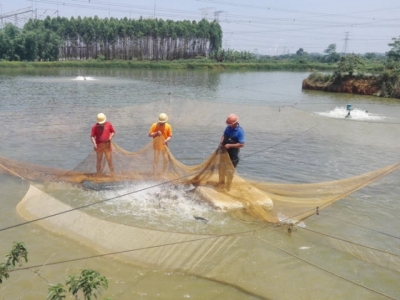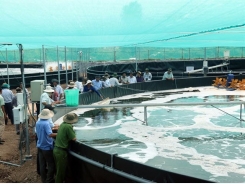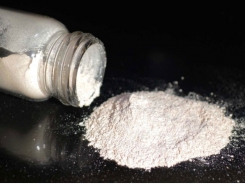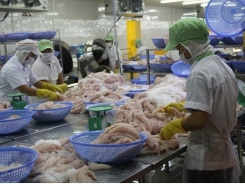Bio-economic modeling for improving aquaculture performance (Part 1)

Integrating fish growth with financial analysis can help farmers optimize operations
Harvesting tilapia from a pond in China. Photo by Junning Cai.
The Food and Agriculture Organization of the United Nations (FAO) has been devoted to helping farmers worldwide to improve the performance of their aquaculture operations. As part of this effort, a bio-economic model of tilapia pond culture has been developed based on experiences in China, the largest tilapia farming country accounting for more than 30 percent of the nearly 6 million metric tons (MT) of global tilapia aquaculture production in 2015.
Information and insights provided by the model indicate that bio-economic modeling can be a knowledge-based, climate-smart innovation for improving the performance of aquaculture. With the aim of attracting more attention and participation to bio-economic modeling, this article explains the key features of the model, highlights some insights revealed by it and discusses the way forward.
Detailed discussion on the methodology and results of the bio-economic model can be found in the Fisheries and Aquaculture Technical Paper No. 608 (Cai, J.N., Leung, P.S., Luo, Y.J., Yuan, X.H. & Yuan, Y.M. 2018. Improving the performance of tilapia farming under climate variation: perspective from bio-economic modeling. Rome, FAO).

View of tilapia ponds. Photo by Junning Cai.
1/ Why bio-economic modeling?
Like most agricultural activities, aquaculture is a complicated business that entails careful planning to balance the influence of many factors. Fish farmers usually plan their operations based on common practices, own experiences or expert advice. While farmers continually accumulate experiences in good farming practices and arrangements through trial and error, learning by practicing and knowledge-sharing among peers, experience-based business and operational planning tends to be inaccurate and less flexible in adapting to changes in environmental, technical or economic conditions.
Investment/financial models, such as the User-Friendly Tool For Investment Decision Making in Aquaculture (UTIDA) developed by FAO, have been used to help farmers or other practitioners to assess the performance of aquaculture operations for investment decisions or loan applications. While these models are also used to facilitate business planning, they are less capable in advising on optimal farming arrangements, such as when to stock the fish, how many fish to stock, when to harvest the fish, etc. Indeed, these models usually require users to first specify the farming arrangement of an operation (e.g. fingerling size, stocking density and growing period) as well as its outcomes (e.g. harvest size and the overall FCR) and then input the technical specification into the models to assess the financial performance (profitability, solvency and liquidity) of the operation.
Bio-economic modeling, which integrates detailed modeling of fish growth with financial analysis, can help farmers optimize their farming and business arrangements under ever changing climate, technical and market conditions. It represents a knowledge-based innovation that can improve the technical and financial performance of aquaculture under given farming conditions.

Sample of tilapia feed used in China. Photo by Junning Cai.
2/ Key features of the bio-economic model of tilapia pond culture
The bio-economic model of tilapia pond culture in Cai et al. (2018) simulates tilapia growth under a certain feeding regime. In the model, a farmer is required to feed the fish according to a feeding schedule recommended in a technical guidebook on tilapia farming in China. The feeding schedule specifies daily feed rations according to fish body weights and the water temperatures. Based on the feed rations as well as the size of fish and the fish biomass in the pond, daily fish growth is estimated by the model, and the estimation accounts for the impacts of the water temperature and stocking density on fish growth.
In the model, a farmer is required to adopt good aquaculture practices, including (1) using good quality fingerlings and good quality feed with appropriate crude protein contents for fish at different growing stages, (2) following proper water quality management protocols such as the use of biological or chemical products for water treatment and installation and proper use of aeration facilities and (3) harvesting the fish before the fish biomass in the pond reaches a certain carry-capacity threshold.


Good-quality fingerlings are very important. Nursing tilapia fry (left). Tilapia fingerlings being weighed before stocking (right). Photos by Junning Cai.
Under these preset technical requirements, a farming arrangement is to decide four technical parameters: stocking timing, fingerling size, stocking density and growing period. Stocking timing matters because the bio-economic model accounts for seasonal variation in the water temperature. Crops starting at different stocking timings are subject to different water temperatures hence have different fish growth patterns.
Different combinations of the four technical parameters would result in a number of farming arrangements. Fish growth under these arrangements can be simulated and the resulting technical and economic performance evaluated in the model, and the arrangements that give the best performance can be identified by comparison.
3/ Higher productivity ≠ higher profitability
Many simulation results of the bio-economic model indicate that farming arrangements that increase productivity (measured by kg/ha/week) may not always improve profitability (measured by CNY/ha/week; 1 Chinese Yuan, CNY = 0.16 US dollar). While this may not be a novel insight for some experts, it is often under-appreciated by farmers as well as researchers in their constant pursuit of higher yields without adequate attention to profitability.
The bio-economic model provides a conceptual framework and examples to help people understand why profitability and productivity may not go hand in hand. Intuitively, profitability is determined by productivity as well as profit margin which is equal to the fish sale price minus the cost per unit of production (aka break-even price). An increase in productivity can be accompanied by a decrease in profit margin, especially when the fish are getting bigger with lower feed efficiency. When the impact of increase in productivity is prevailed by decrease in profit margin, profitability would decline notwithstanding the productivity hike.


Pond-side tilapia harvest and loading for transport. Photos by Junning Cai.
4/ Profit maximization for individual crops ≠ overall profit maximization
Many bio-economic models in the literature (see citations in Cai et al. 2018, pp. 1-2) focus on identifying optimal stocking density or growing period (also called harvest time) under a farming environment with stable water temperatures. However, pond culture in reality is usually subject to different water temperatures during a year. With the impact of seasonal water temperature variation accounted for, the simulation results of the bio-economic model indicates that a farming arrangement that gives a high profitability in an individual crop may not result in a high overall profitability in a multi-crop operation.
As indicated in Fig. 1, the arrangement of a one-year, two-crop operation (given 1-gram fingerlings) starting at the best initial stocking timing (9 April, represented by orange dotted lines) would be nearly 20 percent more profitable than the arrangement starting on the least profitable initial stocking timing (18 June, represented by blue dotted lines. There is a two-week break for pond preparation between the harvest date and the stocking date for the next crop.).
However, the least profitable arrangement includes a highly profitable first crop (2,268 CNY/ha/week) and a second crop with much lower profitability (941 CNY), whereas the profitability of the two crops under the most profitable arrangement is more balanced (1,552 CNY/ha/week and 1 973 CNY/ha/week, respectively).

Fig. 1: Most versus least profitable arrangements under one year, two crops (1-gram fingerlings). Source: Cai et al. (2018, p.41). Note: mu is a land area measure used in China (1 ha = 15 mu).
Indeed, an intriguing result is that a one-year, two-crop arrangement where the profit is maximized in both crops given their respective stocking timings may nevertheless not maximize the overall profitability. We encountered such cases when testing a stepwise strategy, under which a farmer would first determine the profit maximizing arrangement for the first crop, then determine the one for the second crop, the third crop and so on. We found that under the stepwise strategy, the farming arrangement could eventually converge to a one-year, two-crop arrangement with profit maximization in both crops. To our surprise, we found that the arrangement would nevertheless not maximize the overall profitability.
Intuitively, as the harvest timing of a crop affects the stocking timing of the next one, the arrangement of an individual crop would affect not only its own performance but also that of the next crop. When the arrangement that maximizes the profitability of the first crop results in a less opportune stocking timing for the second crop, even with the maximum profitability achieved in both crops, the overall profitability could be suboptimal. In other words, with path dependency, the stepwise strategy that maximizes the profitability of individual crops separately is not necessarily a strategy that maximizes the overall profitability; farmers should take a holistic approach to maximize the overall profitability of multiple crops.
Related news
Tools

Phối trộn thức ăn chăn nuôi

Pha dung dịch thủy canh

Định mức cho tôm ăn

Phối trộn phân bón NPK

Xác định tỷ lệ tôm sống

Chuyển đổi đơn vị phân bón

Xác định công suất sục khí

Chuyển đổi đơn vị tôm

Tính diện tích nhà kính

Tính thể tích ao




 Bio-economic modeling for improving aquaculture performance (Part 2)
Bio-economic modeling for improving aquaculture performance (Part 2)  Exports of tra fish earns 438 million USD…
Exports of tra fish earns 438 million USD…